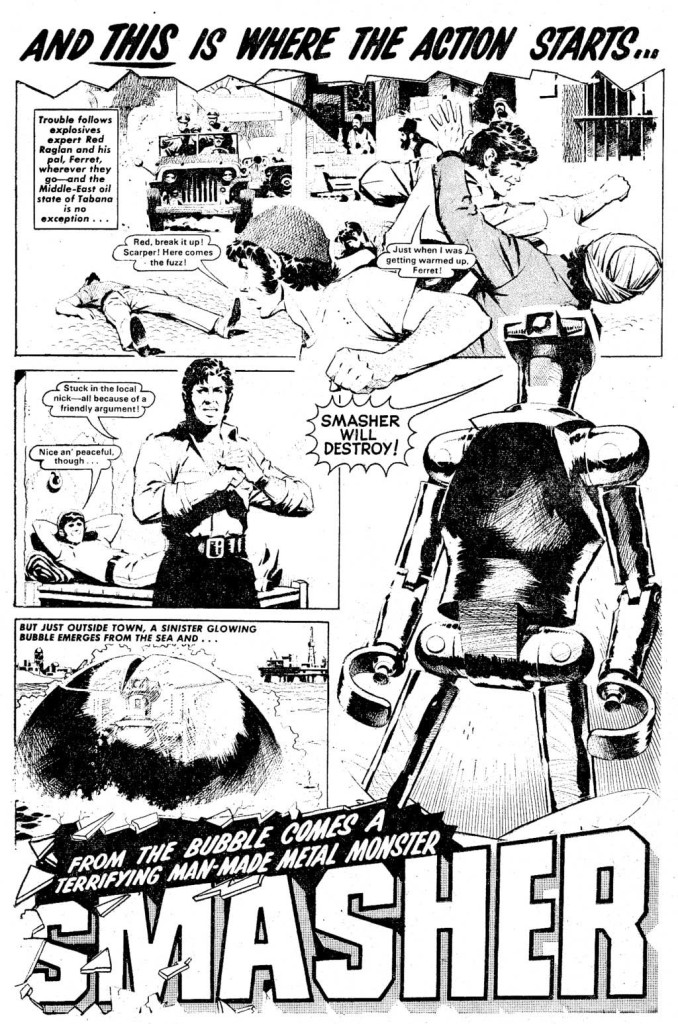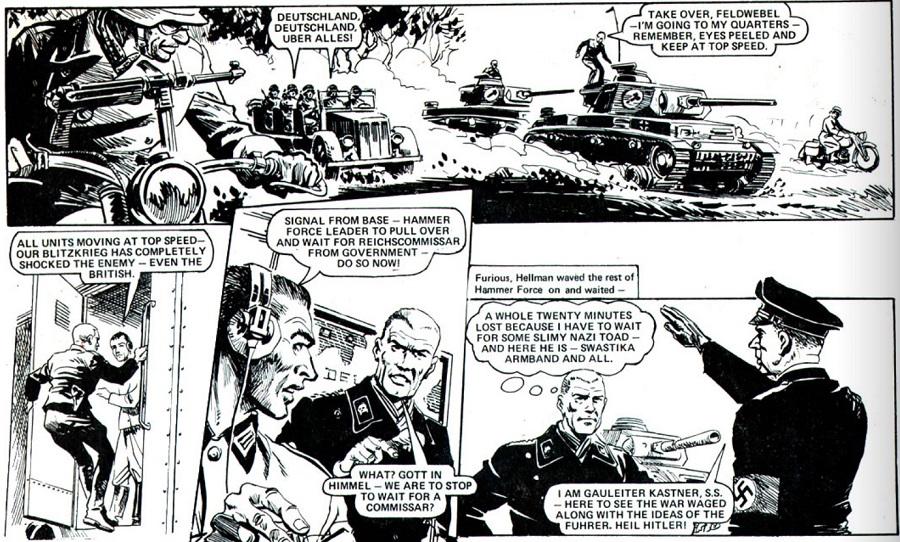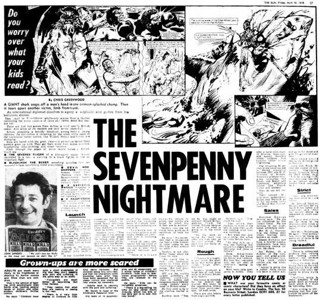Valentine’s Day is usually considered a time for lovers, but this year – 2016 – it’s year for lovers of Action… and Bullet, two British boys’ comics celebrating their 40th anniversary. Although, sadly, neither of course are still being published, both left a lasting legacy that fans and comics historians have been arguing over for almost as long.
Older readers of downthetubes will instantly recognise the titles, which both have cover dates of 14th February 1976 (although of course, these are the off-sale dates, when newsagents would remove said issue from their shelves in favour of the next edition. IPC’s quick-to-be banned Action actually launched on Saturday 7th February and DC Thomson’s Bullet two days later).


I’d noted the fast-approaching milestone anniversary date some months ago, but as the date approached, real life interfered and I forgot about them until comic artist Lew Stringer reminded us that he had discussed these comics on his Blimey! It’s Another Blog About Comics blog back in 2008.
He recently had a second look at Action with a lovely post about some of the vibrant covers of pre-ban Action here, but I’ll add a little more where I can, especially as the cover artist for Bullet Issue One is none other than Jeff Bevan, a DC Thomson staff artist who I’m currently documenting for a Creator Spotlight article for this site.
Inside, readers were treated to a variety of great strips. “The Smasher” centred on a giant robot, built by one Doctor Doom, a villain bearing no relation to the more famous Marvel character who looked like remarkably like Jason King from Department S. The robot was repeatedly opposed by Red Raglan and his mate Ferret, and was in some ways a successor to the original Smasher robot, who first appeared in text stories in The Wizard and The Dandy in the 1930s, then as a strip in Victor in the 1960s, with Alan Philpott and Tony Coleman sharing the artistic credits.
The Bullet version was drawn by the always brilliant Terry Patrick and Ian Kennedy on drawing duties. This version featured above is an example of Ian Kennedy’s work on the series.
Looking through Issue One of Bullet, two stories that still stand up well are “Twisty” and “Vic’s Vengeance“. “Twisty” is a grittier take on the football story than most DC Thomson fare, with Twisty Lunnon having an almost uncanny ability to control the ball. Imagine Wizard‘s “Limp Along Leslie” from the wrong side of the tracks if you prefer. And thank Barrie Mitchell for some wonderful art.
“Vic’s Vengeance” – drawn by Richard Jennings from a script by William Corduroy, was the tale of a teenager who was out to get revenge against the local mob who has organised the death of his father, a story that was definitely darker than your normal DC Thomson fare – but when compared to Bullet‘s competition on the news stand over in Action, it still looks a little tame…
Action – the brainchild of Pat Mills, developed in just three months at the instigation of IPC Editorial Director John Sanders, stories ruthlessly plundered social culture and pushed the stories and the characters right up to the edge of the envelope and beyond. In the cinema, we had Jaws, Cross of Iron and Dirty Harry: Action gave us “Hook Jaw“, “Hellman of Hammer Force” and “Dredger“. And kids of the 1970s loved it. In fact, it was loved so much that Action was one of the few comics to increase its sales as 1976 went by, no doubt boosted by the furore its content stirred up that finally resulted in it being banned and all but a few file copies of one edition, Issue 37, getting pulped (One of those surviving copies sold for a small fortune at auction last year).
The original comic was in touch with what kids wanted at the time. But Action fell foul of much more conservative times when it tried to mix political ideas with its ultra-violent approach.
“Hook Jaw“, for example, the title’s best-known strip, written by Ken Armstrong and initially drawn by Ramon Sola, wasn’t just a story with loads of gore and blood – it also was one of the first British comic strips to put across a strong ecological message.
“Hellman of Hammer Force” – the work of writer Gerry Finley-Day, drawn by Mike Dorey, wasn’t a Nazi fighting mindlessly for Hitler, but he a German patriot fighting for his country just like all the other soldiers that fought in the Allied Forces. Even in the 1970s, many still could not accept the idea that not all Germans were Nazis.
Dredger was a British secret agent that owed more to Clint Eastwood’s Dirty Harry Callahan than James Bond. And he was definitely not one of your stiff upper lip heroes, as we can see from the centre panel in the second row. The attitude was definitely more punk rock than patriotic fervour.
As we can see from just these three examples, Action was a lot more in tune with the times than Bullet – and the authorities didn’t like its “message”, any more than they liked the working classes seeing films such Battleship Potemkin in previous decades, which was banned from cinemas between 1926 and 1954 for its “inflammatory subtitles and Bolshevist Propaganda” (Other films, such as The Proud Valley starring Paul Robeson were among those that faced the censor’s knife for their content).
National newspapers ran articles about Action within weeks of the launch: it was The Sun that dubbed it “The Seven Penny Nightmare“, which brought it to the attention of National Viewers’ and Listeners’ Association and led to a widespread campaign to censor Action and questions in the House of Commons (sadly, we’ve been unable to find the actual debate).
In October 1976, Action disappeared from the shelves of newsagents for six weeks, while it was systematically toned down in order to assuage the concerns of the moral panic that it had created. On its return, it was a lobotomised version of its former self and only managed to keep going for another eleven months before it was merged into Battle.
On a purely financial basis, Bullet was the better of the two as it managed to last almost three years, whereas Action did not last two years. But for impact, Action is still sending out waves today, as without the manufactured moral panic that led to the demise of Action, we would not have the 2000AD that we have today.
So let’s celebrate these two comics. Launched on almost the same day in 1976, they produced wildly different results.
• Action, launched by IPC on 7th February 1976 (cover dated 14th February 1976), backed by a £50,000 media campaign; ran for 36 issues in its original run, relaunched and merged with Battle in 1977 – 87 issues in total (including the pulped Issue 37)
• Bullet, launched by DC Thomson on 9th February 1976 (cover dated 14th February 1976), ran for 147 issues before merging with Warlord in 1978
• There’s an affectionate tribute to Bullet here by horror writer Mark West on his Strange Tales site
• Moose Harris’ brilliant web site about Action was, sadly, a victim of web hosting problems, but the Internet Archive has snapshots of some this terrific resource here, including this brief history (sans images)
• If you are interested in looking deeper into the life and death of Action, then you have to try and track down Action: The Story of a Violent Comic by Professor Martin Barker. Incredibly, no publisher has sought to update or re-publish this fascinating book
This article was first published in on my NothingButAFan blog – and then John Freeman got his mitts on it
All images © Rebellion and DC Thomson. A tip of the hat to David Roach for information on the creator so “Vic’s Vengeance” and with thanks to John Archbold for the ‘Bullet’ promotional ads
A life-long comic fan, specialising mainly in UK adventure comics, Colin did his very best to support his passion for the comics of his youth, Commandos (still going!) and any small press that interested him. Sadly, Colin passed in March 2021, an invaluable downthetubes team member, much missed by us all
Categories: British Comics, British Comics - Current British Publishers, downthetubes Comics News, downthetubes News, Features









 In Review: The Leopard from Lime Street – Birthright
In Review: The Leopard from Lime Street – Birthright  Quantum Leap! We go behind the scenes on Time Bomb Comics flagship anthology
Quantum Leap! We go behind the scenes on Time Bomb Comics flagship anthology  Anna Morozova and Alberto Navajo join Commando ranks
Anna Morozova and Alberto Navajo join Commando ranks  In Review and In Pictures: The Commando and British Comics Swap Meet, April 2023
In Review and In Pictures: The Commando and British Comics Swap Meet, April 2023
Great post (and thanks very much for the link too) – forty years, eh?
I know… scary, isn’t it!
It’s not difficult to track down a copy of Martin Barker’s book about Action.
Finding a couple of hundred quid to buy it…
That might count as difficult.
http://www.abebooks.co.uk/servlet/SearchResults?an=Martin+barker&sts=t&tn=Action
I hope it’s in libraries!
I know Titan Books looked at reprinting this more than once. Here’s hoping…